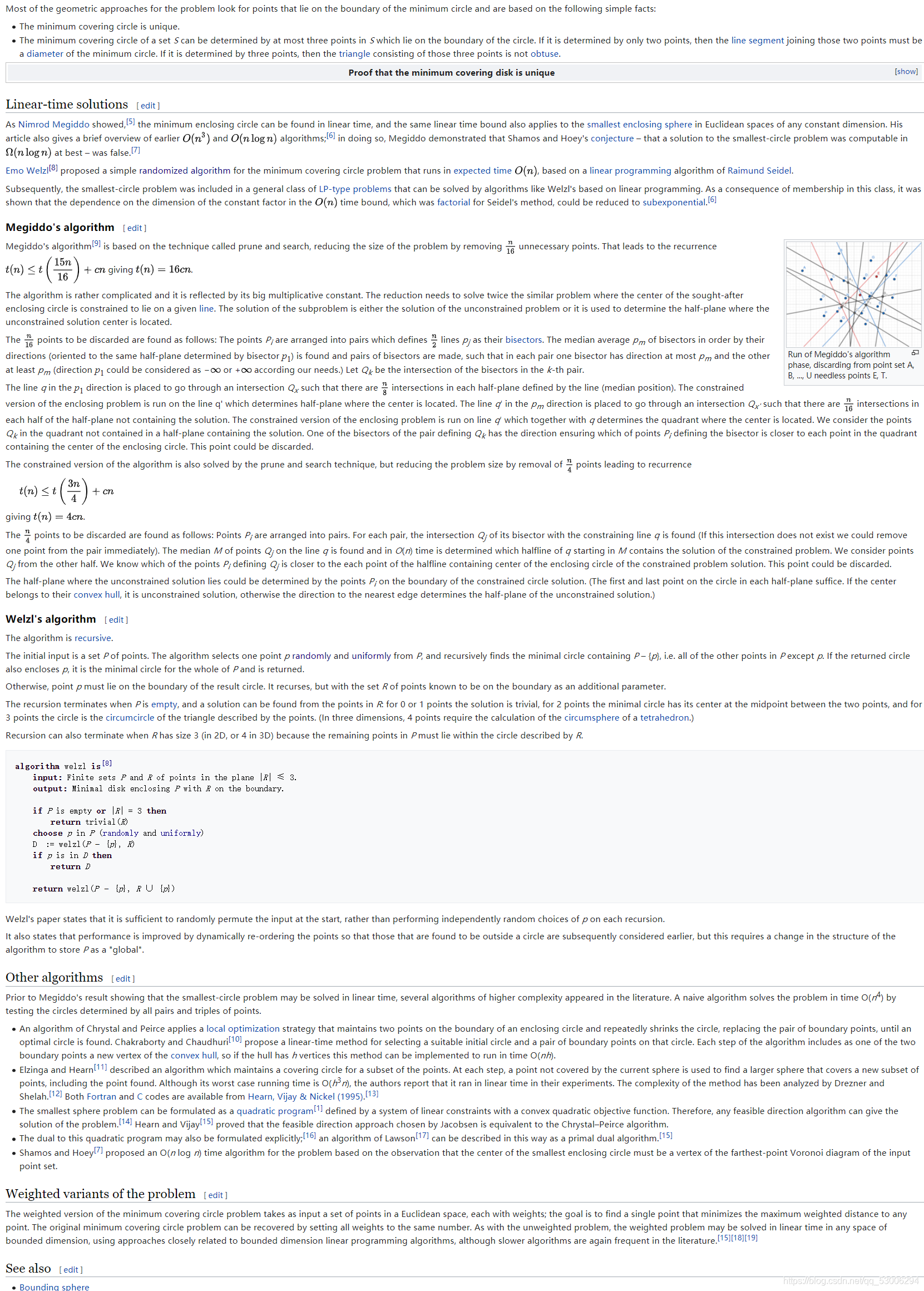@TOC
参考文献: https://en.wikipedia.org/wiki/Smallest-circle_problem 维基百科上关于最小圆覆盖有很全面的论述(需要科学上网) https://baike.baidu.com/item/%E6%9C%80%E5%B0%8F%E5%9C%86%E8%A6%86%E7%9B%96%E7%AE%97%E6%B3%95/22799983 百度也有
提示:以下是本篇文章正文内容,下面案例可供参考

algorithm welzl:
input: Finite sets P and R of points in the plane
output: Minimal disk enclosing P with R on the boundary, or undefined if no such disk exists
if P is empty or |R| ≥ 3:
if |R| = 1:
(we do this to support multisets with duplicate points)
(we assume that a circle with a radius of zero can exist)
p := R[0]
return circle(p, 0)
else if |R| = 2:
(we do this to support multisets with duplicate points)
(we use that the smallest circle between two points has a center at their midpoint)
(and the segment that passes through them is a diameter of the circle)
p0 := R[0]
p1 := R[1]
center := midpoint(p0, p1)
diameter := distance(p0, p1)
return circle(center, diameter / 2)
else if the points of R are cocircular:
return the ball they determine
else:
return undefined
choose p in P (randomly and uniformly)
D := welzl(P - { p }, R)
if p is in D:
return D
return welzl(P - { p }, R ∪ { p })The algorithm is recursive.
The initial input is a set P of points. The algorithm selects one point p randomly and uniformly from P, and recursively finds the minimal circle containing P – {p}, i.e. all of the other points in P except p. If the returned circle also encloses p, it is the minimal circle for the whole of P and is returned.
Otherwise, point p must lie on the boundary of the result circle. It recurses, but with the set R of points known to be on the boundary as an additional parameter.
The recursion terminates when P is empty, and a solution can be found from the points in R: for 0 or 1 points the solution is trivial, for 2 points the minimal circle has its center at the midpoint between the two points, and for 3 points the circle is the circumcircle of the triangle described by the points. (In three dimensions, 4 points require the calculation of the circumsphere of a tetrahedron.)
Recursion can also terminate when R has size 3 (in 2D, or 4 in 3D) because the remaining points in P must lie within the circle described by R.

It also states that performance is improved by dynamically re-ordering the points so that those that are found to be outside a circle are subsequently considered earlier, but this requires a change in the structure of the algorithm to store P as a "global".


代码如下:
#include <vector>
#include <iostream>
#include <stdlib.h>
#include <time.h>
#include <opencv2/opencv.hpp>
using namespace cv;
using namespace std;
typedef vector<Point> Points;
class Circle
{
public:
Circle(Point2f c, double r) :center(c), radius(r) {}
double radius;
Point2f center;
friend ostream & operator<<(ostream& output, Circle &c);
};
ostream & operator<<(ostream& output, Circle &c)
{
output << c.center << "," << c.radius;
return output;
}
//ay+bx+c=0
class LinearEquation
{
public:
LinearEquation() {}
//参数
LinearEquation(int _a, int _b, int _c) :a(_a), b(_b), c(_c) {}
//两点式
LinearEquation(Point A, Point B) {
a = (A.x - B.x);
b = -(A.y - B.y);
c = (A.y*B.x - A.x*B.y);
}
//点斜式
LinearEquation(double _a, double _b, Point A) {
a = _a;
b = _b;
c = -(_a*A.y + _b*A.x);
}
double getA() { return a; }
double getB() { return b; }
double getC() { return c; }
double getSlope() { return -b / a; }
double getIntercept() { return -c / a; }
friend void Get2LinesIntersection(LinearEquation &l1, LinearEquation &l2, Point2f &intersection);
friend double distance(Point2f A, Point2f B);
private:
double a, b, c;
};
//求两线交点
void Get2LinesIntersection(LinearEquation &l1, LinearEquation &l2, Point2f &intersection)
{
intersection.x = -(l1.a *l2.c - l2.a*l1.c) / (l1.a*l2.b - l2.a*l1.b);
intersection.y = (l1.b *l2.c - l2.b*l1.c) / (l1.a*l2.b - l2.a*l1.b);
}
//求两点距离
double distance(Point2f A, Point2f B)
{
return sqrt((A.x - B.x)*(A.x - B.x) + (A.y - B.y)*(A.y - B.y));
}
//获取三点最小圆覆盖
//方法:中垂线交点(垂心)为外接圆圆心
Circle GetMinCircleOf3Points(vector<Point> &v3)
{
Point2f center;
double radius;
// two edges of the triangle v1, v2
LinearEquation l1(v3[0], v3[1]);
LinearEquation l2(v3[0], v3[2]);
Point2f midPoint1 = (v3[1] + v3[0]) / 2.0;
Point2f midPoint2 = (v3[2] + v3[0]) / 2.0;
LinearEquation midperpendicular1(l1.getB(), -l1.getA(), midPoint1),
midperpendicular2(l2.getB(), -l2.getA(), midPoint2);
// center is intersection of midperpendicular lines of the two edges v1, v2
Get2LinesIntersection(midperpendicular1, midperpendicular2, center);
radius = distance(center, v3[0]);
return Circle(center, radius);
}
//获取两点最小圆覆盖
Circle GetMinCircleOf2Points(vector<Point> &v2)
{
Point2f center = (v2[0] + v2[1]) / 2;
double radius = distance(v2[0], v2[1])/2;
return Circle(center, radius);
}
//点在圆内?
bool isPointInCircle(Circle c, Point2f p)
{
return distance(p, c.center) < c.radius ? true : false;
}
/*algorithm welzl is
input : Finite sets P and R of points in the plane | R | ≤ 3.
output : Minimal disk enclosing P with R on the boundary.
if P is empty or | R | = 3 then
return trivial(R)
choose p in P(randomly and uniformly)
D : = welzl(P −{ p }, R)
if p is in D then
return D
return welzl(P −{ p }, R ∪{ p })*/
Circle welzl(Points P, Points R)
{
if (R.size() == 3)
{
return GetMinCircleOf3Points(R);
}
else if (P.empty())
{
if (R.size() < 2)
return Circle(Point2f(0, 0), 0);
else//R.size=2
return GetMinCircleOf2Points(R);
}
Point p = P.back();//p为最后一个点
P.pop_back();//P-{p}
Circle C = welzl(P, R);//递归求解P-p最小圆覆盖
if (isPointInCircle(C, p))//若p在P-p的最小覆盖圆内
return C;
R.push_back(p);//p在P-p的最小覆盖圆外
return welzl(P, R);//p为边界点,记录至R中,递归寻找边界点存入R
}
int main()
{
srand(time(0));
Points pts, bound;
int count = 4, bottom = 400, right = 400, left = 200, top = 200, img_rows = 600, img_cols = 600;
Mat img(Size(img_rows, img_cols), CV_8UC1);
img = 0;
cout << "生成随机点:" << endl;
int r , c ;
for (int i=0;i<count;i++)
{
r = rand() % (bottom-top)+top;
c = rand() % (right-left)+left;
Point p (c, r);
pts.push_back(p);
circle(img, p, 2, 255);
cout << p;
}
cout << endl;
Circle cResult= welzl(pts, bound);
cout << cResult;
circle(img, cResult.center, cResult.radius, 255);
imshow("result", img);
waitKey();
return 0;
}其中Circle welzl(Points P, Points R)为核心函数,参数P为输入点集,参数N为边界点集,及位于最小覆盖圆上的点,可能为两个或者三个。 其中N是边界点集,一定位于最小圆上,N为求解最小圆的关键,通过上述递归求出。 P为输入点集,每递归一次就减一个。 最终N有3个或者P为空递归停止。 情况1:N为3。说明边界点已经找完了。 情况2:P为空。N为2不一定找完,可能还有一个点,所以得通过递归遍历所有剩余点,如果所有点都在这个2个边界点构成圆里面(就是以两边界点为直径的圆),也就是P为空(所有点都遍历了一遍),则递归也可以结束。
本人也在学习中,疏忽之处在所难免,有错误欢迎指出。
